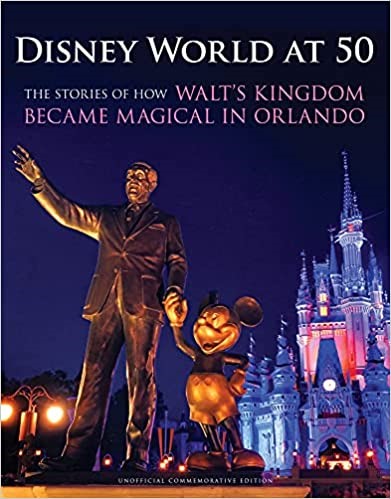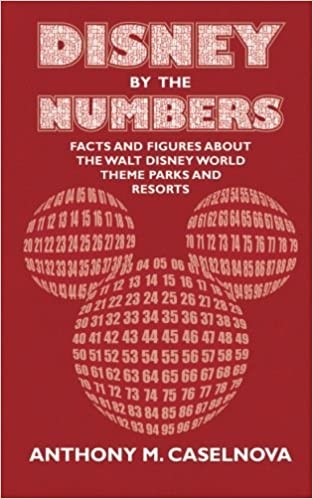Category — A Friday Visit with Jim Korkis
Fridays with Jim Korkis: Disney World at 50
Welcome back to Fridays with Jim Korkis! Jim, the dean of Disney historians, writes about Walt Disney World history every Friday on yourfirstvisit.net.
YOUR PERSONAL DISNEY LIBRARY (48)
By Jim Korkis
- Disney World at 50: The Stories of How Walt’s Kingdom Became Magic in Orlando from the Orlando Sentinel
This commemorative edition from the Orlando Sentinel is a treasure chest filled to overflowing with long lost lost gems of information and photos. As I’ve mentioned before, I expected several books to appear to celebrate Walt Disney’s World 50th anniversary, but I never expected this book and I was ectastic to add it to my personal collection.
Disney World at 50 is a beautifully put together 176 page hardcover book (with a dust jacket) produced by the staff of the Orlando Sentinel that has covered the creation and expansion of Walt Disney World for over fifty years. It was this same newspaper that first revealed that it was Walt Disney buying land in Florida, thanks to its reporter Emily Bavar.
The book features not only excerpts from her historic article but also a reproduction of the front page of the newspaper with the announcement and a full page photo of a smiling Bavar standing next to a smiling Walt at Disneyland in 1965. It always amuses me that the “girl reporter,” as she was described by the newspaper and elsewhere then, was actually forty five years old when she met and interviewed Walt.
Disney World at 50 is filled with excerpts from Orlando Sentinel newspaper stories giving the date and the reporter’s byline. Accompanying these excerpts are black-and-white and color photos from the archives of the newspaper, most never seen since their original publication.
While the majority of Disney World at 50 concentrates on the earliest days of Walt Disney World, there are article excerpts and photos of everything from the opening of the other parks to Pleasure Island to the impact of the coronavirus to a look at “coming attractions”.
In my own writing, I have often used vintage Orlando Sentinel articles for information, but this book includes some that I missed in my research. It was the Orlando Sentinel who revealed that the first costumed Mickey Mouse at Walt Disney World was Doug Parks, who had to go through three auditions to get the role. That article is reprinted here along with a photo of Parks from 1971.
Disney World at 50 is filled with new stories as well as familiar stories from a different perspective. Just looking at the photos is a delight although in one shot, the staff seemed unable to identify on page ten Admiral Joe Fowler on the Florida property with Walt Disney–although it was able to identify a partial head shot of Joe Potter.
That is a very minor quibble and certainly mitigated by the two pages of full color photos of the famous 1965 press conference and color shots of the models of the never-built Persian and Venetian resort hotels among other treats. Even the obligatory construction photos of the Magic Kingdom are out-of-the-ordinary.
It is not just the photos but the quotes found in the articles that never appeared elsewere. In one article excerpt about the opening day of the Magic Kingdom, CEO Card Walker told the reporter: “If I had any regret, it is that a guy called Walt Disney wasn’t here to enjoy it.” Try finding that quote anywhere else in a book or article or website describing opening day.
Or in that same article, Walt Disney Productions president Donn Tatum telling the same reporter why Roy O. Disney was not present for the opening day ceremonies. Tatum said, “Roy had to leave because of a serious illness in his wife’s family. We are sorry he could not be here, and it is difficult to estimate when he will return.” Of course, he was there for the dedication ceremony two weeks later.
Such gems are scattered throughout the book that I give my highest recommendation. It is a charming and valuable addition to Walt Disney World history, and if you have any interest in Walt Disney World history it should have a prominent place on your shelf.
* * * * *
Thanks, Jim! Come back next Friday for more from Jim Korkis!
In the meantime, check out his books, including his new books Vault of Walt: Volume 10: Final Edition, Kungaloosh! The Mythic Jungles of Walt Disney World and Hidden Treasures of Walt Disney World Resorts: Histories, Mysteries, and Theming, much of which was first published on this site.
Follow yourfirstvisit.net on Facebook or Twitter or Pinterest!!
January 28, 2022 No Comments
Fridays with Jim Korkis: A Lost Dreamfinder Film
Welcome back to Fridays with Jim Korkis! Jim, the dean of Disney historians, writes about Walt Disney World history every Friday on yourfirstvisit.net.
DREAM FINDER RUN
By Jim Korkis
“A very serious, very advanced engineering project is being built in Florida around these new Disney characters: Dreamkeeper and his pet dragon Figment…It will be only part of a total experience that people will remember all their lives.” –Kodak in-house magazine advertisement, 1980
Yes, the iconic Dreamfinder was once going to be called “Dreamkeeper” after he had evolved from Imagineer Tony Baxter’s concept for a Professor Marvel for the never built Discoveryland section at Disneyland.
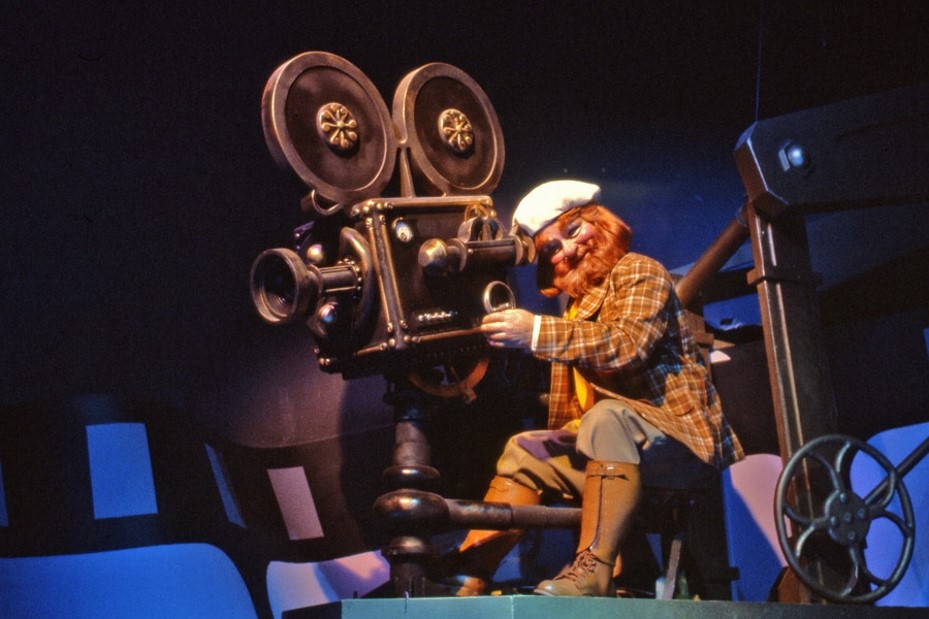
(c) Disney
When EPCOT Center opened on October 1, 1982, actor Ron Schneider, costumed as the character, explained to Bryant Gumbel on the Today show who Dreamfinder was supposed to be:
“Well, I’m kind of the host of the Journey Into Imagination show out here at Epcot Center. I traveled all over the Universe, collecting the stuff dreams are made of: Sounds, Colors, Ideas . . . Anything that sparks the imagination. And I store these sparks in the Journey Into Imagination Pavilion. And the guests and I recombine them into new ideas and new inspirations.”
While Dreamfinder and Figment were there at the opening of Epcot, their attraction, Journey Into Imagination, did not officially open at the Imagination Pavilion until March 5, 1983.
The Imagination pavilion was to house an attraction featuring these characters and also a 3-D film titled Magic Journeys, directed by Murray Lerner. However, there was some concern that the film might not be ready in time for the opening of the pavilion, so Imagineering decided to prepare a back-up plan.
The Walt Disney Company contacted filmmaker Mike Jittlov, who was well-known for his 1979 short film, The Wizard of Speed and Time. Jittlov was asked to produce a 70-second live-action film featuring Dreamfinder that could be used to introduce about five minute of clips from Magic Journeys as a back-up, in case the entire 3-D film wasn’t finished in time.
Contrary to other descriptions, this segment was not done in Jittlov’s well known stop-motion technique except for a few seconds, nor was it in 3-D in order to better showcase the 3D clips.
The film was titled Dream Finder Run, because, at that point, the name Dreamfinder was two separate words, and basically the character was going to run around a lot.
The film begins with Dreamfinder putting on his coat and talking to the off-camera Figment: “Figment, my impatient young friend, you can’t push creativity. It takes time to do things right.”
Figment (off camera): “And isn’t now the time for a preview of the Magic Journeys film?”
Dreamfinder: “By golly, you are right. I better hurry along.”
There was one day of filming in Florida and two days in Tujunga, California, at WED (Imagineering). The film had the character running around in the Imagination pavilion while it was still being constructed, as well as passing projects being built at the WED workshop in California.
Dreamfinder spends brief seconds in each location. Jittlov has a cameo, as does the shadowy silhouette of Mickey Mouse. Figment appears on the desk of a sculptor, as well in the basket of a bicycle (as a tribute to the film E.T.).
At one point, Dreamfinder grabs a reel of film (supposedly Magic Journeys). He inadvertently runs off the edge of a second floor hallway and lands in a pile of film cans. Looking at the audience, he informs them it is now time to put on the 3-D glasses to see the preview of scenes from Magic Journeys.
Lerner, who was directing Magic Journeys, found out about this back-up plan and rushed to finish his film. It premiered on time so Dream Finder Run was never shown in its entirety.
However, a clip of a few seconds from Dream Finder Run was shown in the television special Epcot Center: The Opening Celebration on October 23, 1982. Danny Kaye and a very young Drew Barrymore meet Dreamfinder and his puppet Figment outside the original attraction transitioning into about eight seconds from the film.
* * * * *
Thanks, Jim! And come back next Friday for more from Jim Korkis!
In the meantime, check out his books, including his new books Vault of Walt: Volume 10: Final Edition, Kungaloosh! The Mythic Jungles of Walt Disney World and Hidden Treasures of Walt Disney World Resorts: Histories, Mysteries, and Theming, much of which was first published on this site.
Follow yourfirstvisit.net on Facebook or Twitter or Pinterest!!
January 21, 2022 No Comments
Fridays with Jim Korkis: Card Walker
Welcome back to Fridays with Jim Korkis! Jim, the dean of Disney historians, writes about Walt Disney World history every Friday on yourfirstvisit.net.
CARD WALKER
By Jim Korkis
Esmond Cardon Walker, more commonly known as Card Walker, died November 28, 2005 at the age of 89 from heart failure. Even though he retired from the Walt Disney Company in 1983, Walker continued to serve as a consultant to the company until 1990, and was member of the board of directors until 1999.
After Walt Disney died in 1966, Walker became executive vice president and chief operating officer. When Walt’s brother Roy O. Disney died in 1971, he became company president, serving under Chairman and CEO Donn Tatum. He became CEO in 1976, opening Epcot and serving through February 1983, but stayed on as chairman of the board until May 1 to oversee the opening of the Tokyo Disneyland in Japan.
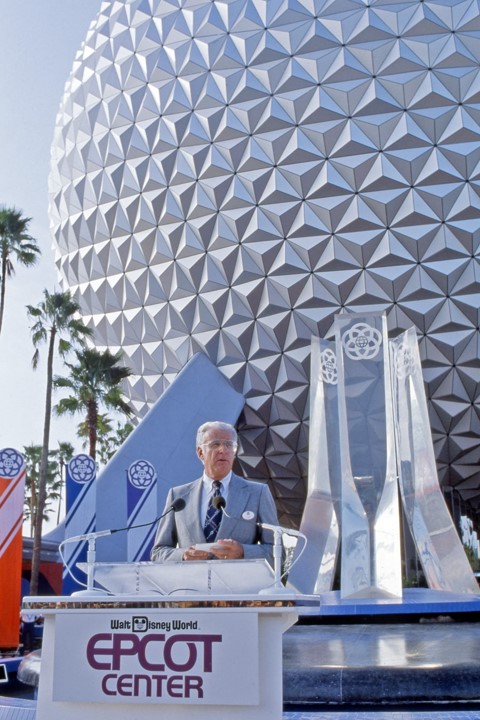
(c) Disney
In 1990, then CEO Michael Eisner said, “In a very real sense, Card is the link between the small, family-owned film company of the ’30s and the major global corporation we are today.”
Here is a brief excerpt from a speech Walker gave entitled “Walt Disney World: Master Planning for the Future” given on October 5, 1976 to the 40th anniversary convocation of the Urban Land Institute where he talked about building Walt Disney World.
“Not all the construction was actually here on the site. The monorail trains for example, were designed and engineered by our Disney staff in California and then assembled at the Martin Marietta plant in Orlando.
“We also required 337 monorail beams to be precision cast using the first major application for three-dimensional, pre-stressed concrete. The nearest place that could handle the work was Tacoma, Washington, so we had to ship them 3,000 miles across the United States to our property.
“Overall, the construction program was the largest non-governmental project in the world at the time. At the peak of the building activity, we had more than 8,000 construction workers on the property at one time. This created another kind of problem.
“In order to train many of the good-looking young hostesses and tour guides, we had to take them through the construction areas. And every time we did, it literally caused a work stoppage. Well, we finally got smart and put them in coveralls and old coats before the construction crews would see them. Productivity went back up after that considerably.
“With the opening date only a year away, we made a detailed evaluation of the construction progress and problems. Finally, we decided that the only way we could finish on schedule was to assume the construction responsibilities ourselves.
“No one understood what we were trying to accomplish or how to come to grips with the unprecedented construction problems any better than our own people. So right in the middle of the stretch run, we formed our own construction company, Buena Vista Construction, and managed to bring the project in on time, October 1, 1971.
“Needless to say, we were pretty nervous when opening day rolled around. Why did we choose October 1st? Quite frankly, we wanted to sneak it open. We deliberately chose the slowest month of the year because we needed a shakedown period where we could deal with smaller numbers of guests before the really big tourist season hit.
“But for Walt Disney World’s opening, the rumors were really flying. Some people had predicted that more than a million people would show up. Soon, everybody in Central Florida was believing it. And, despite the low tourist period of the year, pretty soon we were beginning to believe it ourselves.
“People were afraid to come out of their houses. The opening day crowd was, you might say, ‘underwhelming’. We had almost as many employees as guests. Well, after that, they did come. This week marks our fifth anniversary of operation and in that time, more than 59 million people have gone to Walt Disney World. Today, it stands as the number one tourist destination in the world.”
* * * * *
Thanks, Jim! And come back next Friday for more from Jim Korkis!
In the meantime, check out his books, including his new books Vault of Walt: Volume 10: Final Edition, Kungaloosh! The Mythic Jungles of Walt Disney World and Hidden Treasures of Walt Disney World Resorts: Histories, Mysteries, and Theming, much of which was first published on this site.
Follow yourfirstvisit.net on Facebook or Twitter or Pinterest!!
January 14, 2022 No Comments
Fridays with Jim Korkis: Dick Tracy’s Crime-Stoppers at Walt Disney World
Welcome back to Fridays with Jim Korkis! Jim, the dean of Disney historians, writes about Walt Disney World history every Friday on yourfirstvisit.net.
THE DICK TRACY’S CRIME-STOPPPERS ATTRACTION
By Jim Korkis
Dick Tracy (1990) was an expensive movie produced by the Walt Disney Company through its Touchstone brand.
Even as film production got underway in February 1989, CEO Michael Eisner had Walt Disney Imagineering develop a major “E Ticket” attraction for the Disney MGM Studios park (now Disney’s Hollywood Studios) that would capture the excitement of the film.
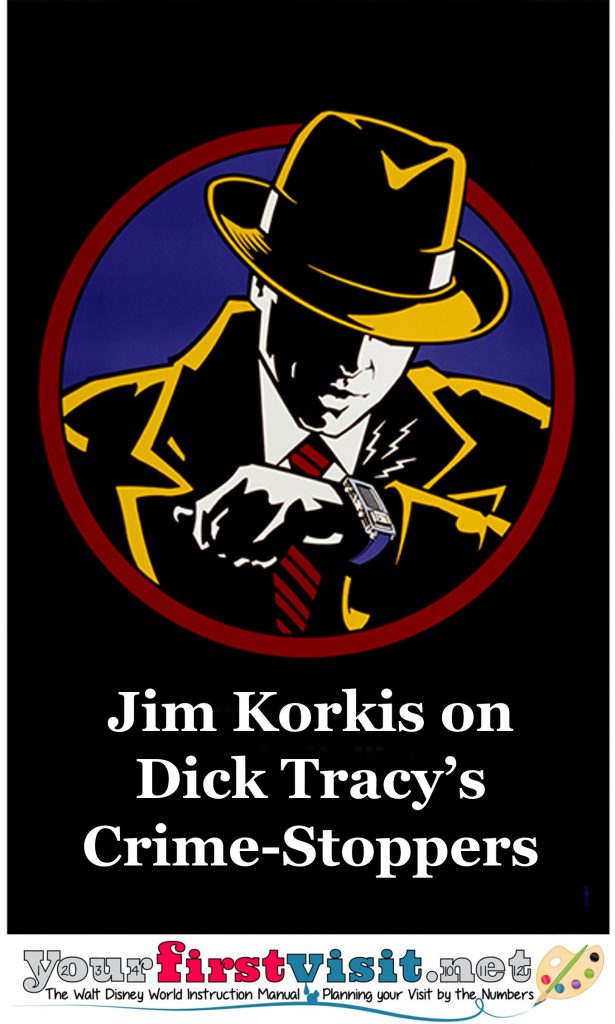
The attraction was to be located at the end of Sunset Boulevard in the area that now includes Rock ’n’ Roller Coaster and the Tower of Terror, in a section called Chicagoland that would have been themed to Chicago during the wild Roaring Twenties.
The exterior of the attraction building would have looked like a warehouse on a seedy waterfront street. In addition, there would have been a food and beverage location and merchandise shop devoted to selling Dick Tracy merchandise and promoting possible movie sequels.
The ride attraction would put guests inside an old-fashioned roadster as it roared through the streets of Chicago of the 1920s when vicious gangsters ruled the city.
As they careened at seemingly dizzying speeds with the vehicle lurching back and forth wildly through buildings, over bridges, and past the Chicago docks, they would have confronted audio-animatronic infamous Dick Tracy crooks, except the guests were armed with their own tommy guns so they could participate in the bullet blazing action from the movie.
The cars would have been based on the same type of vehicle that was later used in Disneyland’s Indiana Jones attraction and Disney’s Animal Kingdom Dinosaur attraction. It would have been able to safely recreate rocking and tipping movements of a high-speed chase.
The gun system was based on one that was later incorporated into Walt Disney World’s Buzz Lightyear’s Space Ranger Spin and Disneyland’s Buzz Lightyear’s Astro Blasters. It would later be utilized in Toy Story Midway Mania.
Basically, in the Crimestoppers’ attraction, the guns would shoot a stream of light (with machine gun sound effects) at objects that would react when hit like a rattling trash can or the sound of shattering window.
Supposedly, part of the concept was that sometimes different things could happen each time you shot something which would increase the rideability of the attraction like shooting the top off of the trash can or the scream of a cat from inside of it.
Of course, this violent action brought up the concern about whether this fit into the Disney brand to have guest participate activities like shooting at people, even if they were only audio-animatronics.
The concept renderings are very reminiscent of the streets under the elevated tramway at the American Waterfront of Tokyo Disney Sea.
Eisner expected that the film would do so well that Disneyland would’ve gotten a whole new addition called Hollywoodland that would’ve been an idealized version of the film capital’s “Golden Age” from the ‘20s and ‘30s. A version of Dick Tracy’s Crime-Stoppers would’ve been the major new attraction there as well.
Disney sadly over-estimated star Warren Beatty’s box office appeal, and the public’s interest or connection with the character. However, the park did feature a live-action stage show, Diamond Double Cross, featuring Dick Tracy, and there was a display of costumes and props from the movie at the park as well.
With no excitement surrounding the initial release, no sequels on the way, EuroDisney bleeding money, and no new Tracy merchandise to push, there was little reason to build an expensive new attraction.
* * * * *
Thanks, Jim! And come back next Friday for more from Jim Korkis!
In the meantime, check out his books, including his new books Vault of Walt: Volume 10: Final Edition, Kungaloosh! The Mythic Jungles of Walt Disney World and Hidden Treasures of Walt Disney World Resorts: Histories, Mysteries, and Theming, much of which was first published on this site.
Follow yourfirstvisit.net on Facebook or Twitter or Pinterest!!
January 7, 2022 No Comments
Fridays with Jim Korkis: Disney by the Numbers
Welcome back to Fridays with Jim Korkis! Jim, the dean of Disney historians, writes about Walt Disney World history every Friday on yourfirstvisit.net.
YOUR PERSONAL DISNEY LIBRARY (47)
By Jim Korkis
- Disney by the Numbers by Anthony M. Caselnova
Disney by the Numbers: Facts and Figures About the Walt Disney World Theme Parks and Resorts is an offshoot of the internet site disneybythenumbers.com.
This 141 page book, released in 2015 and never updated, is devoted entirely to Walt Disney World, with individual chapters on each theme park, the water parks, resorts, dining, recreation (golf courses and Disney’s Wide World of Sports), transportation (railroad and monorail) and “mousecellaneous.”
Disney by the Numbers is not a book of stories. It is a listing of numbers. The content within each chapter is not necessarily presented in any particular order. It is more the type of book to just flip open and casually read a page or two and be fascinated by the numbers. Each page is filled with facts and figures about a particular aspect of the property.
Author Caselnova worked at Walt Disney World as a security guard, and like many cast members in the 1990s was given a copy of the “That’s A Fact” pocket-sized reference booklet with the subtitle “The Official Facts About the Walt Disney World Resort.”
Primarily it had opening and closing times of the parks, admission prices, names of the resorts, etc. but it also included some numerical facts to help in answering guest questions. Walt Disney’s personal philosophy was that cast members should know the answers or know where to get the answers.
These books were given free to cast members with a new edition coming out each quarter printed in a different color so that cast members could recognize the latest edition to give accurate information since things were constantly changing at Walt Disney World. These books are sometimes offered for sale on eBay, sometimes at outrageous prices.
Caselnova took the facts from his collection of different editions and organized them all in a spreadsheet and then started his website. He supplemented the information from other sources as well.
So the challenge was that while some facts never change like the length of Main Street U.S.A. or the number of Alucobond panels on Spaceship Earth or the date construction began on the Wedding Pavilion, other things are always changing like the number of topiaries at the International Flower and Garden Festival and how many Mickey-shaped waffles are served at Chef Mickey’s each day.
The reviews on Amazon point out that sometimes a fact will appear in Disney by the Numbers and it will be contradicted later. That probably occurred from the author grabbing a fact from different places or a different time period. The other complaint is about misspellings.
Perhaps because I am familiar with Walt Disney World and familiar with the “That’s A Fact” booklet that I used many times as a cast member, it was easy for me to determine what facts were “set in stone” and which ones were current when the book was compiled but have changed.
The facts that are “set in stone” are as accurate as any other official information from Walt Disney World, like the height of Cinderella Castle, the approximate cost of the construction of Epcot, how many secondary limbs are on the Tree of Life and similar things.
While working at Walt Disney World, one of my roles was to occasionally help out with the “Fun Facts” sheets given to the media for events. I can share that sometimes those facts were best estimates.
However, since Disney by the Numbers was released in 2015, there are facts about extinct attractions like the Great Movie Ride, Horizons, and Mickey’s Toontown Fair in the book to jog some memories but that also means that newer additions to the property since then are obviously missing.
Keep in mind the caveat in the publicity from the publisher: “This is not a book of words. It is a book of numbers.”
* * * * *
Thanks, Jim! Keep in mind that this is very different than a similarly titled, but much more important book—Buzz Price’s Walt’s Revolution: By the Numbers, and come back next Friday for more from Jim Korkis!
In the meantime, check out his books, including his new books Vault of Walt: Volume 10: Final Edition, Kungaloosh! The Mythic Jungles of Walt Disney World and Hidden Treasures of Walt Disney World Resorts: Histories, Mysteries, and Theming, much of which was first published on this site.
Follow yourfirstvisit.net on Facebook or Twitter or Pinterest!!
December 31, 2021 No Comments
Fridays with Jim Korkis: Bill Clinton in the Hall of Presidents
Welcome back to Fridays with Jim Korkis! Jim, the dean of Disney historians, writes about Walt Disney World history every Friday on yourfirstvisit.net.
BILL CLINTON IN MAGIC KINGDOM’S HALL OF PRESIDENTS
By Jim Korkis
President Bill Clinton made his debut as the first currently sitting U.S. president to speak in the Magic Kingdom’s Hall of Presidents on October 1993.
Veteran Walt Disney Imagineering sculptor Blaine Gibson came out of retirement to sculpt the Clinton bust, as he had sculpted virtually all the Hall of Presidents figures up to that point. He started work on the bust in late November 1992.
Gibson’s protégé Valerie Edwards spent time with Gibson at his home in Sedona, Arizona to observe and discuss technique, so that she could continue with future presidents.
Gibson acquired information on Clinton from sources as diverse as the White House staff, the state of Arkansas gubernatorial photographer, and numerous publications.
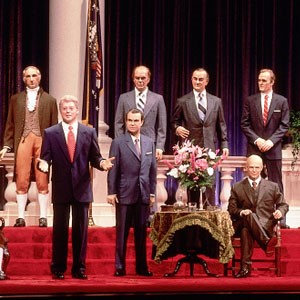
(c) Disney
“My goal in sculpting is to render the uniqueness of an individual,” said Gibson. “I read a lot about him, as much as I could find. A caricaturist would make Clinton’s chin jut out, but I didn’t want to create a cartoon. President Clinton is a man of persistence and tenacity and I tried to reveal some of those qualities.”
The Clinton bust was molded, cast in bronze, and attached to a marble base at an outside foundry under Gibson’s supervision, a process that took approximately eight weeks. The bust was later presented to Clinton.
For the audio-animatronics figure in the attraction, Gibson created another bust without hair. Like the other presidential figures, a hand-tied wig would be fabricated for the figure, making the figure look more realistic and the hair easier to style. Disney’s MAPO (Manufacturing And Production Organization, named for Mary Poppins) Plastics made a tooling to create the likeness and the hot-melt skin.
Walt Disney World Central Shops produced the plastic body sections for the final figure. These sections were shipped back to MAPO in California where principal animation designer Stan Abrahamson created the animation sheets that served as a function list that listed all intended figure movements and a parts list of mechanical equipment necessary for those movements.
The parts were fitted inside the plastic body shell. After the president recorded his speech at the White House, the hand movements had to be reworked, because Clinton did not speak with an open hand but with a closed fist thumb-up gesture.
Michael Horen, in charge of Head Animation Assembly, said “I studied Clinton on television and his lips slide toward the side of his face when he pauses between words. I had my doubts about whether I could approximate this expression because I don’t think we’ve tried to capture it on another figure before.”
Hydraulic values at the base of the figure were connected to the actuators that provide the figure’s movement. The wiring took four days. Once completed, the entire figure was monitored and re-calibrated for another ten days.
For the wardrobe, costumers fashioned a navy blue, single-breasted European suit and a red-and-white polka dot tie. Additional information was supplied by the White House staff on details such as shoe size (13D) and even the simple black sportsman’s watch Clinton preferred. The watch came with a 12 page instruction booklet and took hours to program.
When the figure arrived at WDW in mid-October, it went through an eight-day test-and-adjust session.
Imagineer Rick Rothschild said, “We walk a really fine line between showing the president as he looks in the media, the one we are familiar with on magazine covers and television, and the ‘real’ Bill Clinton, the person who looks different every day just like the rest of us. I’m aiming for somewhere in between.”
* * * * *
Thanks, Jim! There’s more form Jim on Bill Clinton in the Hall of Presidents here and here. And come back next Friday for more from Jim Korkis!
In the meantime, check out his books, including his new books Vault of Walt: Volume 10: Final Edition, Kungaloosh! The Mythic Jungles of Walt Disney World and Hidden Treasures of Walt Disney World Resorts: Histories, Mysteries, and Theming, much of which was first published on this site.
Follow yourfirstvisit.net on Facebook or Twitter or Pinterest!!
December 24, 2021 No Comments

